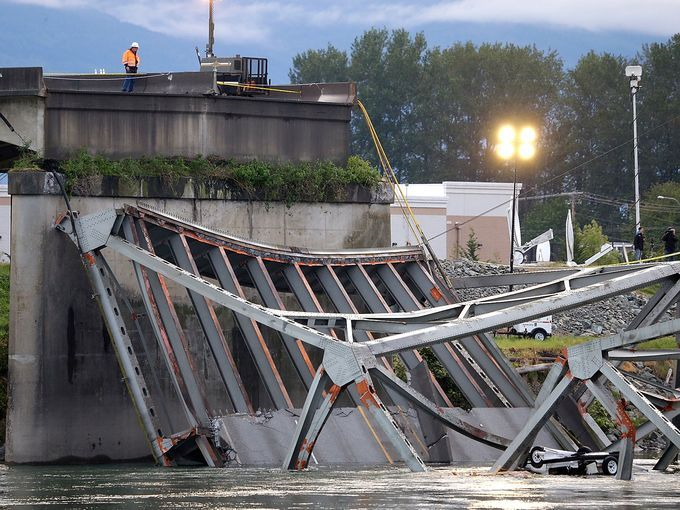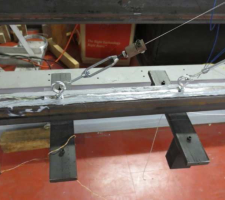
David Crawford discovers how new systems and services are helping authorities in the US deal with a backlog of bridge maintenance.
Every day 185 million vehicles – cars, trucks, school buses, emergency response units - cross one or more of America’s 55,710 ‘structurally compromised’ steel and concrete road bridges, the highest concentrations of which are in Iowa (nearly 5,000), Pennsylvania and Oklahoma. Nearly 2,000 of these crossings are located on interstate highways, according to the American Road and Transportation Builders Association’s recent analysis of the
The overall tally of defective structures has fallen by around 0.5% a year since 2010, according to the US Federal Highway Authority, while the percentage of those in good condition has remained relatively steady. But, at current rates, it will take more than two decades to clear the backlog, according to the American Road and Transportation Builders Association’s chief economist, Dr Alison Premo Black.
She points out that almost 174,000 of all US road bridges (around 28%) are over 50 years old and have never undergone any major reconstruction. The scale of the issue underlines the continuing need for more effective means of prioritising the most serious cases for attention.
The problem lies in the historic inability of conventional non-destructive evaluation tools, which are designed to test the integrity of materials without damaging them, to yield sufficiently location-specific results - underlining the need for new technologies. Among US knowledge centres responding to the crisis is the
He cites governments like those in Hong Kong and Korea which are mandating that new bridges have such monitoring technology installed from the outset - giving such investment a higher priority than is currently the case in the US. The problem, as always, when considering retrofitting existing structures with networks of smart sensors, is the cost.
Among other regional efforts,
The UIC team trialled its approach on a scale model of the recently opened, three-span Chongqing Dongshuimen bridge over China’s Yangtze River. This showed that a telecoms grade, optical fibre-based strain sensor identified damaged cable, irrespective of location.
The same group is developing a bridge-specific weigh-in-motion approach to gather safety-critical information. By deploying fibre-optic sensors, the system measures the shear forces generated by traffic loads flowing around structural supports. UIC’s Dr Farhad Ansari told ITS International that the equipment can normally be non-intrusively installed (and maintained from) underneath the bridge deck, thereby avoiding the need for lane closures. A series of truck runs have validated the concept.
Avoiding closures for structural checks is also the aim of a US$1.4 million research grant by the USDoT to a consortium led by Missouri University of Science and Technology. It is developing a robotic arm for inspecting and maintaining bridges either from the sides of the bridge or from the air.
Mounted on unmanned aerial vehicles (drones) or robots crawling along the sides of structures, the arm will be fitted with sensors and microwave cameras capable of detecting potential problems before they become serious. They will be able to apply sealants or protective paints to individual sections under the remote guidance of engineers, who will control the work and visually check the results via monitor screens.
With these new tools, US bridge inspection will be “reinvented and transformed into a more consistent, reliable and rapid process,” according to the university’s Professor Genda Chen. He is also director of a new federal university transportation centre entitled Inspecting and Preserving Infrastructure through Robotic Exploration.
Meanwhile, the
According to the National Bridge Inventory, the US has more than 18,000 ‘fracture-critical’ bridges - those with one or more steel members in tension which, if they failed, which would cause partial or complete collapse. Early detection of this type of problem is the aim of start-up company Resensys, which presented its wireless fault monitoring system at a September 2016 meeting of the Northeast Bridge Preservation Partnership in Baltimore.
Renesys’ small-scale, low-maintenance Senspot devices are designed for the long-term monitoring of strain variations caused by both temperatures and live traffic – including overstrains caused by drivers of overweight vehicles ignoring the maximum load restrictions. They can also be used to monitor the condition of existing cracks. Founder Mehdi Kalantari, of the University of Maryland, told
The issue of providing energy to power such devices on often-remote structures has stimulated a series of mains-free initiatives as, according to some US estimates, energy-independent and wireless systems can offer savings on installation and maintenance of between 60% and 70%.
One developer is Lord Microstrain Sensing Systems, whose solar-powered sensors collect data on, for example, the performance of bearings, bridge vibration and longitudinal movement and then wireless transmit that information for cloud storage. An early installation is on a major road bridge over the Corinth Canal, in Greece – an area subject to seismic disturbance.
Another innovator at the University of Texas at Austin, is working on a fast-assembly, energy-harvesting system that uses an electromagnetic generator to convert the vibrations of steel highway bridges into electricity for storage.
At national level, USDoT’s
In October 2015, it launched a web-based bridge portal with a centralised, national repository that enables the rapid access to, and querying of, structural performance-related information, using advanced analysis tools and the integration of resources via data fusion techniques. This offers full access to the Long-Term Bridge Performance data and the recently-released version 1.5 includes National Bridge Inventory data and field-collected outputs to date.
Version 2, due out this September, will include legacy data on, for example, enhancements to bridge deck deterioration modelling and cost analysis. Future developments envisage asset management tools, 3D visualisation techniques and mobile apps for use by engineers in the field.
The FHWA hopes that the correlation of facts on the temporal condition of superstructures, substructures, bearings, joints and coatings will reveal unknown mechanistic properties and will help identify more innovative approaches.
But, to give the last word to Professor Todd, “The technologies are available here, in the US. It’s a matter of getting them optimised, built and deployed. We simply don’t have the investment by government and state agencies to properly manage our bridges. In reality, the US government has done little to nothing in infrastructure investment or advancing technology - despite all the hysteria after the Minneapolis collapse.”
He wants funding to reflect the five-to-10 year timelines needed to mature scientific and engineering concepts, as opposed to the six-to-18 month process to market for industrial products. He also wants to see new bridge monitoring technologies being “integrated and deployed in a systematic manner.”
Iowan initiative
In May 2017, the
Testing times
Cumulative, non-destructive evaluation testing has been carried out for many years and while new methods are being developed, the records from previous tests retain a significant value for road authorities. When the ‘Virginia Test Bridge’ was demolished in 2016, the deterioration data it had generated over a series of checks was too important to lose. So, sections have survived as test beds for, among other things, research into scanning systems for overlaid surface condition monitoring.












